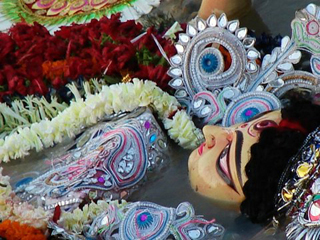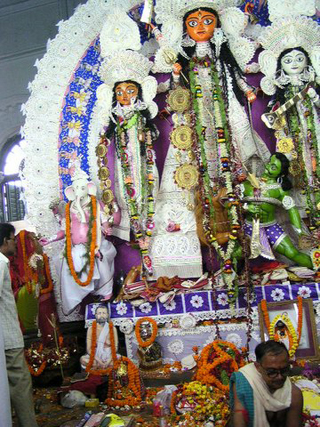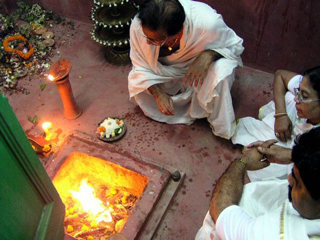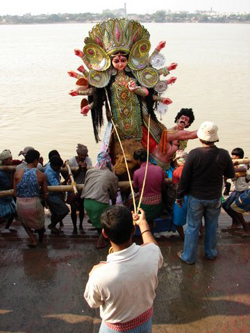Human Flower Project
Kolkata’s Durga: From Home to the Himalaya
Sandy Ao brings a chronicle of the Durga Puja, honoring Hinduism’s Great Goddess and overflowing with flowers in the great city of West Bengal.

A clay idol representing Hindu Goddess Durga
floats in the Hooghly River, Kolkata, India
Photo: Sandy Ao
“So many pandals, so little time!” (“So many” as in 20,000 of these temporary shrines, and that’s in Kolkata alone!)
Headlines of India’s newspapers convey the frenetic and happy spirit of Durga Puja—the long, lush fall festival now winding down. “Now sinking” is more accurate, since after a week of festivity, the clay statues of the Hindu goddess Durga are being taken from their dry-land pedestals down to the closest river’s edge and ritually submerged.
The pandals are ephemeral shrines—temporary structures put together to shelter Durga’s statues, along with all the flowers, food and other offerings given in her honor. During this season, the people of Bengal and much of the rest of India drop everything to visit these splendid altars. The Durga custom is especially strong in Kolkata, making us at the Human Flower Project especially fortunate. Our friend and correspondent Sandy Ao has been trekking all over the city to photograph Durga Puja. This year, rather than visiting the larger community-built pandals and following their parades to the Hooghly River, Sandy sought out an older observance, the traditional family Durga Puja, conducted in private homes.
 A pandal honoring Durga
A pandal honoring Durga
is attended by a pandit (priest)
part of household worship ceremonies known as “puja”
in Kolkata (Calcutta), India
Photo: Sandy Ao
“It’s so different from the Durga Puja that I had been attending my whole life,” she writes.
Worship of the great female goddess Durga may be as old as Hinduism itself, but the celebration to venerate her intensified in Bengal during the Mughal period, the 16th Century. At that time, the wealthy families of the region began to elaborate the old religious rituals with more complex and ostentatious observances. Leading families (in Eastern India’s version of potlatch) put on competitively exorbitant, private displays.
And of course, that requires flowers, lots of them. Sandy tells us that the pink lotus is one flower especially beloved by Durga. But with the puja season extending over several days, each one with its own demands, many other plants and blossoms join the celebration. Among them are marigolds, hibiscus, spicy “kusum” and medicinal “horitoki flowers” (Terminalia chebula Retz.) .
“For the daily puja, simple garlands are used,” Sandy explains, but for Durga puja, “the garlands have to be made with 108 flowers.” This is a sacred number in Hinduism, she says: “Almost all the God and Goddess have 108 names, and it also refers to the reincarnation of lives—108 times.”
Sandy spent most of this holiday visiting the home pujas of the Rashmoni family, who own several sumptuous properties in and around Kolkata. One of them—13 B Rani Rashmoni Street—is occupied by descendants of the fourth daughter of 19th century civic leader Rani Rashmoni (more about her in a later post).
 Offerings are made to the fire god Agni, a purification, before approaching Durga’s statue in ceremonies at 13 B Rani Rashmoni Street
Offerings are made to the fire god Agni, a purification, before approaching Durga’s statue in ceremonies at 13 B Rani Rashmoni Street
Photo: Sandy Ao
Here the durga statue is a doll-like figure dressed in doily white. “The man sitting before the pandal is a pandit (Hindu priest). He is praying for anyone who comes to visit the Goddess Durga,” Sandy explains. She also photographed fire ceremonies. “On the side of the puja hall, there is a room below the floor, the room for offerings to Agni (the fire God). In Hindu religion, praying to Agni is always done first before the other puja begins. Bael wood is used for this ritual. You can see marigold flowers in the pit.”
With ritual foods and flowers, prayers and offerings changing daily (check this listing for some basics), it takes a religious specialist to keep everything in order. One wonders about the social roots of such an elaborate rite. A cynic might ask, “Was it all made this complicated so that only the rich people could worship rightly?”

A pandit (Hindu priest) sits before the pandal to Durga, greeting devotees
in home ceremonies of Durga puja at 13 B Rani Rashmoni Street, Kolkata
Photo: Sandy Ao
Over the last hundred years, the Durga puja celebration has been popularized and, it appears, somewhat secularized too. Now community groups pool resources to build beautiful pandals of their own. Schools and colleges, organizations and even businesses all take part. And just as the old zamindar (property-holding) families of Bengal once used the Durga puja to outdo one another, these popularizers also seem to be melding the god-pleasing rituals and public relations.
For example, we read about the newly established Indian Association of Retired Persons building a pandal, apparently, to lobby for the over-50 crowd. Meanwhile, at a Kolkata college, the pandal manages to celebrate both Durga and the Indian cricket team’s recent victory over Australia.
There’s even an edible pandal.
Sandy Ao’s insight and generosity – as well as her wonderful photographs—help us to quit grappling so determinedly against what can feel like impossible contradictions. She writes:
“The whole concept of Durga is actually the wish for good rainfall during this monsoon season on this side of the Ganges. While immersing the idols, they will bid farewell to Durga, reminding her ‘not to forget to come next year!’
 Devotees bring Durga’s idol to the Hooghly River, the finale of Durga puja, 2007
Devotees bring Durga’s idol to the Hooghly River, the finale of Durga puja, 2007
Photo: Sandy Ao
“She is supposed to go back to her residing place, Kailash (a mountain in the Himalaya) where Lord Shiva, her husband, resides most of the time. The waters of rivers Ganga and Jamuna and Brahmaputra all flow from the Himalaya snows. During monsoons the water rushes down from the hills, enriching the State of Bengal and the country Bangladesh where rice- paddy is cultivated. They say Durga has come down to earth through the rain, by boat. That could be a nice way to pacify us, not to lose heart when we face floods during the rainy season.
“After the monsoon, we will have fine weather for the harvest of the paddies, and the water will be evaporated back to the atmosphere, to the hills and the mountains. When they say ‘do not forget to come and visit us next year…’ they ask that the rain come on time so we will not face drought.” (Here in Texas, we really understand that, Sandy!)
“Actually Hinduism is not a religion,” she writes, “It’s a deep philosophy. Otherwise we humans find it very hard to face hardship in life—if we do not have some good discourse on Nature around us.”
With 108 thanks to you, Sandy Ao!
Comments
” The Asain Paint Committee has staged a different Durga Puja this year. Through these competitions, a magic has been created. It has transformed the whole Kolkata city into a beautiful canvas, making visiting all the Thakur ( Durga/ god/goddess) so meaningful and feel good…
“For those who are unable to witness such beautiful scenes in Kolkata here are the 12 selected best Pujas by The Asain Paits Committee, I am now sending here along with two links of these 12 pujas to facilitate everyone who was not in Kolkata, to be able to enjoy these beautiful pujas of Kolkata 2007 through slides.”
Translation, courtesy of Sandy Ao


Durga Pujo-r aar ekta akarshan holo Asian Paints Sharad Samman. Hoyto ei sab competetion Kolkata’r pujo-ke ekta alada matra ene daye. Sara shahorta koyekdiner jonya ekta Canvas-e rupantorita hoy. Jara jara regular Thakur dekhe, tara eta aro bhalo upalabdhi korte paarbe.
Jader kache duratya ekta badha… tader janyo roilo e-tour. Asian Paints Sharad Samman 2007-er nirikhe Kolkatar sera 12-ta pujo pandal’er kichu chobi’r ekta paripurna slideshow-er link pathalam sabar janyo.
Thanks to Tapas Sengupta of Creative IRIS who has volunteered to make this a reality. Check the URL below to have a glimpse of Kolkata Durga Pujo 2007
http://www.flickr.com/photos/creativeiris/sets/72157602518371549/show/
(Step 1: Click on “Options” at the right hand bottom of the screen
Step 2: Tick on the tab “Always show title and description”
Step 3: “Save” this setting
Step 4: Enjoy… )
or
http://www.flickr.com/photos/creativeiris/sets/72157602518371549/detail/
(Step 1: Click on “View as slideshow”
Step 2: Click on “Options” at the right hand bottom of the screen
Step 3: Tick on the tab “Always show title and description”
Step 4: “Save” this setting
Step 5: Enjoy… )